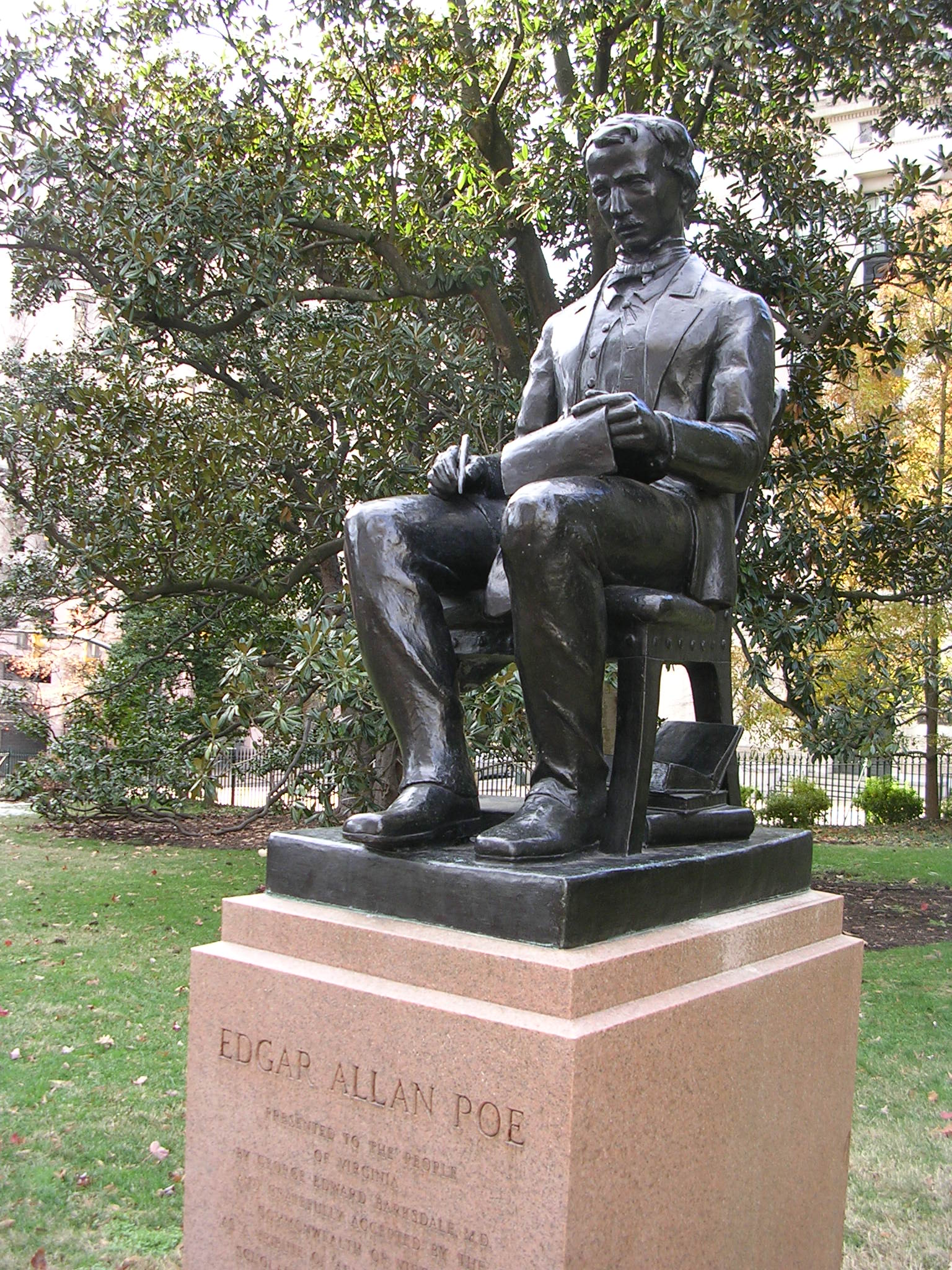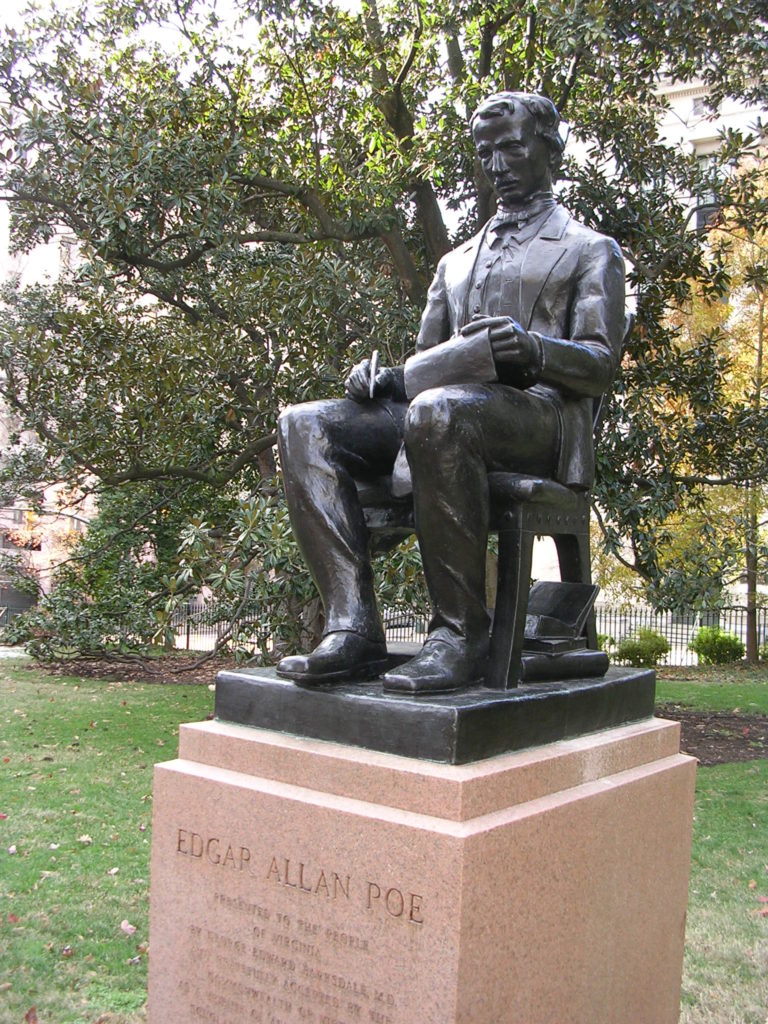
Poe is on the move! After nearly six decades sitting across the street from the home of Poe’s first great love and muse, Richmond’s statue of Edgar Allan Poe has been displaced to make room for some newer sculptures. This is only the latest in many twists and turns in the life of Virginia’s first public Poe statue.
It all began in 1906, when a small band of writers, historians, and artists proposed the installation of a statue of Poe in the author’s hometown. Lack of funding—and a general lack of public enthusiasm—soon brought their efforts to an end. By then, Richmond was already lagging behind other cities in memorializing Poe. Baltimore had placed a Poe monument in Westminster Burying Grounds in 1875. The Actors’ Guild of New York had dedicated their own Poe monument in 1885. This was followed by the University of Virginia’s bronze bust honoring its most famous dropout in 1899. In the years after Richmond’s efforts to construct a statue stalled, Edmond Quinn sculpted a Poe bust for the Poe Cottage in Fordham (installed 1909) while Richmond’s Sir Moses Ezekiel made a statue of a seated Poe for Baltimore (installed 1922).
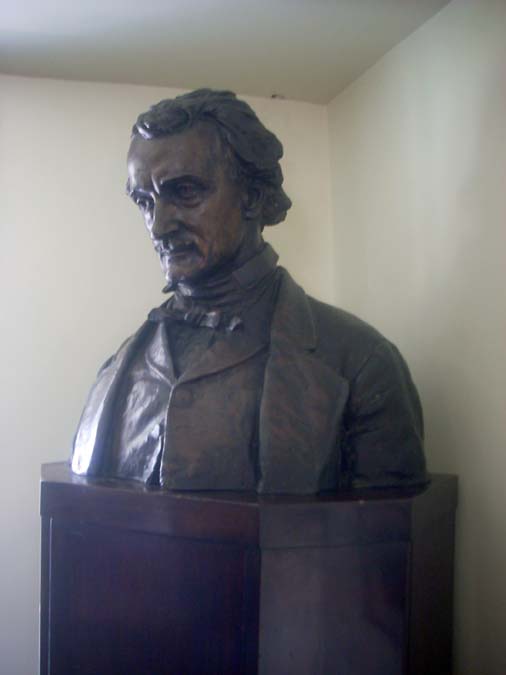
Fifty years later, in 1956, an eighty-seven-year-old retired Richmond physician and his wife were visiting the Poe Cottage. He stood in silence for several minutes in front of Quinn’s Poe bust before turning to tell his wife, “I shall devote the necessary time and money to have Poe recognized by a permanent memorial within the confines of the city he acclaimed as his home.”
Born in Charlotte County in 1869, Dr. George Edward Barksdale had long admired Poe’s works since wiling away hours of his boyhood reading poetry during his free time as a country store clerk. At the same time, he was studying Pharmacy and Chemistry in order to open his own pharmacy in Richmond. A few years later, he attended medical school and eventually became a surgeon and a professor at the Medical College of Virginia. The fortune earned over the course of a long and distinguished career made it possible for him to fund the construction of Richmond’s Poe statue.
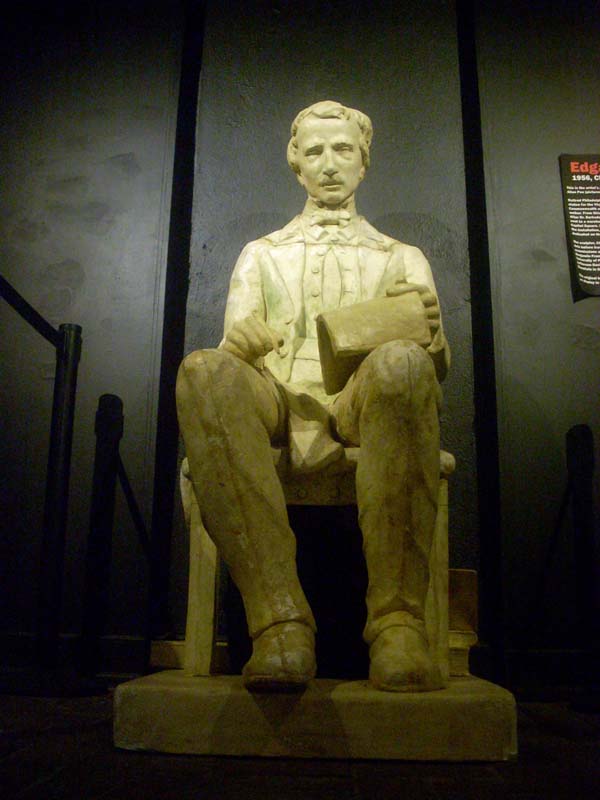
Upon his return from Fordham, Barksdale wrote Virginia Governor Thomas B. Stanley, “I will engage a recognized sculptor to reproduce in bronze a life-sized likeness of Edgar Allan Poe, provided the commonwealth of Virginia will provide a substantial base for the statue to rest upon.” Gov. Stanley forwarded the offer to the Art Commission, which had to select the site and material for the base. There must have been some disagreement over the base, since a rejected sandstone version turned up in a Richmond landfill in the 1970s. (You can now see it on display outside the Poe Museum.)
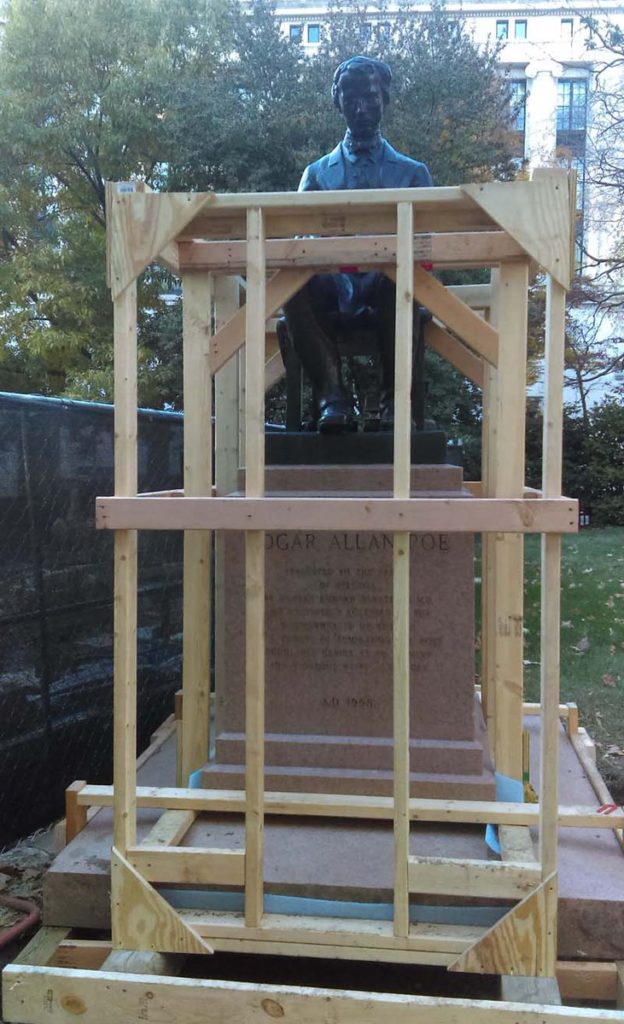
For his statue, Barksdale secured the services of award-winning Pennsylvania sculptor Charles Rudy. Having attended the Pennsylvania Academy of the Fine Arts, where Edmond Quinn had also studied, Rudy went on to win a gold medal from the National Sculpture Society as well as a Guggenheim Fellowship. His most famous commissions include Noah on the Bronx General Post Office, the Confederate War Memorial on Stone Mountain, and two bas-relief profiles of Benjamin Franklin on Philadelphia’s Benjamin Franklin Bridge. Rudy’s Modernist style favored simplified forms over realistic or expressive detail. Critic Bern Ikeler found Rudy’s style “clean, simple, strong.” These terms aptly describe Rudy’s Poe. The seated bronze figure sits stock-straight with his hands on his lap. One holds a pen while the grasps a stack of papers. Underneath his simple, unadorned chair is a pile of books. The face is expressionless; the pose, static. Oddly, the head bears a little more of a resemblance to the aged Barksdale than to Poe.
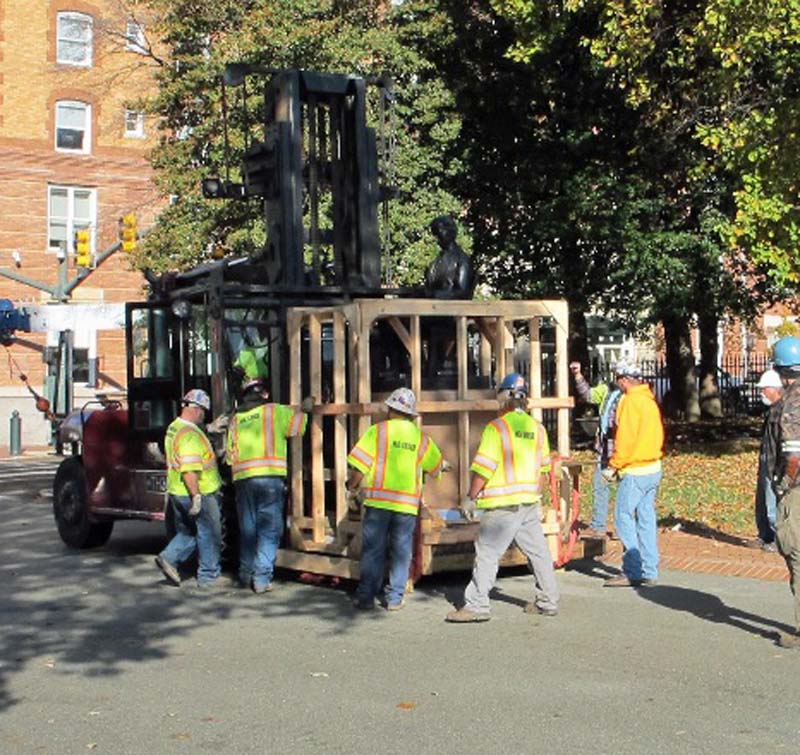
The sculpture may have been ready by 1956, but Virginia was not. Rudy’s bronze sat in storage for two years before finding a home on Capitol Square, in the shadow of Thomas Jefferson’s Virginia Capitol. While the square’s many other public sculptures stood in a row at the top of the hill, Poe occupied a quiet spot all by himself near the bottom. The Arts Commission, however, decided Poe would have liked it there. After all, Jane Stith Craig Stanard, the woman Poe called “the first, purely ideal love of my soul” lived in a house that once stood across the street. As a boy, he visited her there, and she encouraged his writing. After her illness and early death, he dedicated the poem “To Helen” to her. These early verses reference Capitol Square’s classical architecture, and the last stanza begins, “Lo! in yon brilliant window-niche/How statue-like I see thee stand!” It seemed appropriate to place the statue where he could see her in her window-niche—even if he was facing the opposite direction.
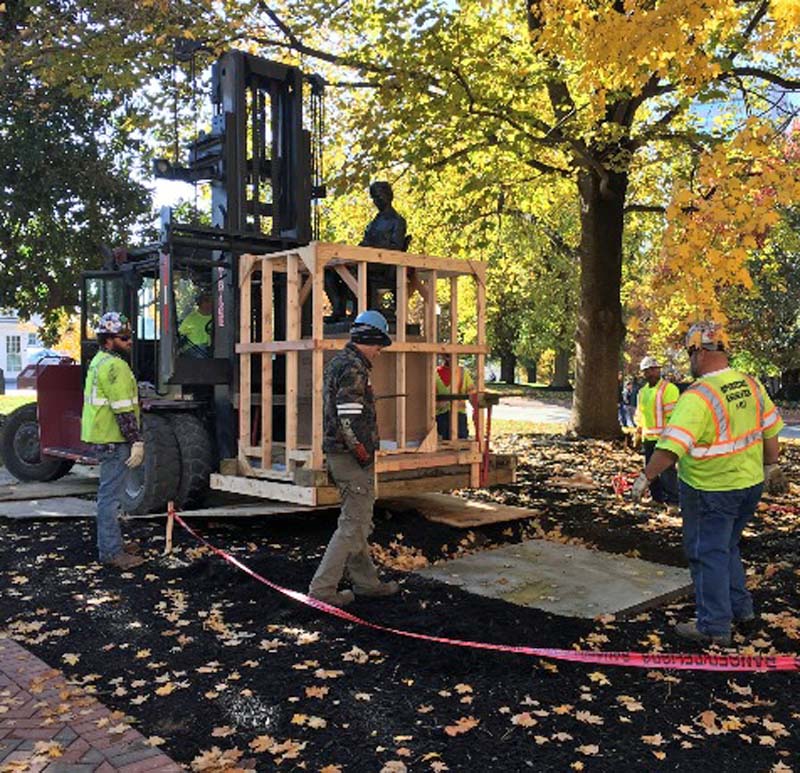
Months after it arrived on the square, the Poe statue was formally dedicated on October 7, 1959—the 110th anniversary of Poe’s death. Virginia’s Attorney General, Albertis S. Harrison, Jr., presided over the ceremony. After an invocation by Dr. William B. Ward of Grace Covenant Presbyterian Church, Mrs. Barksdale unveiled the statue, and University of Virginia professor James Southall Wilson delivered an address. Governor J. Lindsay Almond, Jr. accepted the gift on behalf of the General Assembly of Virginia. The program for the event includes the text of “To Helen” but does not indicate if the poem was recited at the time or who might have done so. One person not in attendance was Dr. Barksdale, who had not lived to see the dedication.
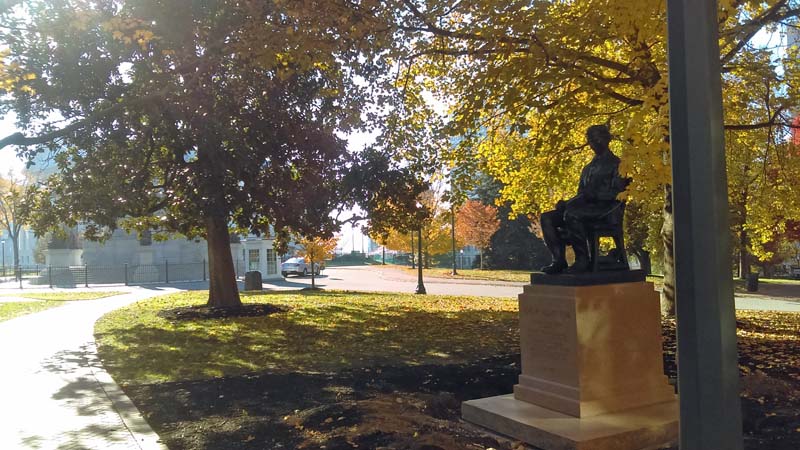
For a town that took a while to build its first Poe statue, Richmond has become a repository for Poe statuary. Among the many pieces now at the Poe Museum are the Actors’ Guild of New York’s previously mentioned Poe monument, a copy of the University of Virginia’s Poe bust, and the plaster version of the Edmond Quinn bust that inspired Barksdale to commission his statue. In 2014, the James Michener Museum of Art even donated the full-sized plaster model of Rudy’s Poe statue, making Richmond home to two different versions.
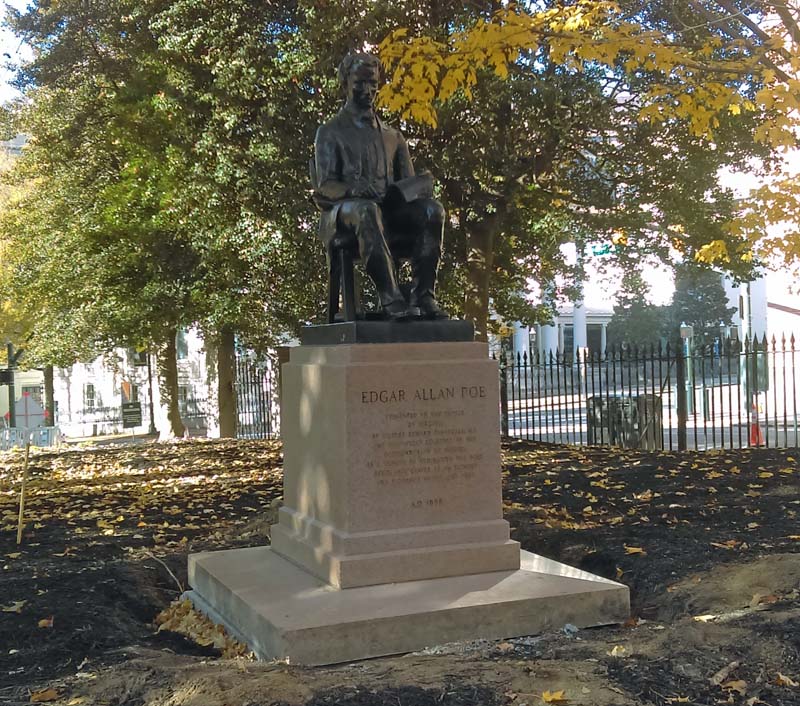
As for Rudy’s and Barksdale’s bronze Poe, on November 22, Fine Art Specialists, experts in moving large artworks, hauled the statue and its polished granite base up the hill to the northwest corner of Capitol Square. Rudy’s Poe now rests in the shadow of Thomas Crawford’s massive 1857 equestrian statue of George Washington, which is itself encircled by sculptures of famous Revolutionary Era Virginians from Thomas Jefferson to Patrick Henry. We like to think of this as the Commonwealth’s long overdue acknowledgement that Poe is one of our literary founding fathers. Poe’s new location also places it near the entrance to the General Assembly Building where he can keep an eye on Virginia’s legislators.

